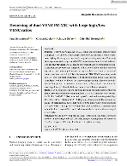Denoising of dual-VENC PC-MRI with large high/low VENC ratios

Datum vydání
2024Publikováno v
Magnetic Resonance in MedicineRočník / Číslo vydání
Volume 93 (January 2025)ISBN / ISSN
ISSN: 0740-3194ISBN / ISSN
eISSN: 1522-2594Metadata
Zobrazit celý záznamKolekce
Tato publikace má vydavatelskou verzi s DOI 10.1002/mrm.30278
Abstrakt
Purpose: Dual velocity encoding PC-MRI can produce spurious artifacts whenusing high ratios of velocity encoding values (VENCs), limiting its ability to gen-erate high-quality images across a wide range of encoding velocities. This studyaims to propose and compare dual-VENC correction methods for such artifacts. Theory and Methods: Two denoisingapproachesbasedonspatiotemporalreg-ularization are proposed and compared with a state-of-the-art method based onsign correction. Accuracy is assessed using simulated data from an aorta andbrain aneurysm, as well as 8 two-dimensional (2D) PC-MRI ascending aortadatasets. Two temporal resolutions (30,60) ms and noise levels (9,12) dB areconsidered, with noise added to the complex magnetization. The error is evalu-ated with respect to the noise-free measurement in the synthetic case and to theunwrapped image without additional noise in the volunteer datasets. Results: In all studied cases, the proposed methods are more accurate than theSign Correction technique. Using simulated 2D+T data from the aorta (60 ms,9 dB), the Dual-VENC (DV) error 0.82 +/- 0.07 is reduced to: 0.66 +/- 0.04 (SignCorrection);0.34 +/- 0.04and0.32 +/- 0.04(proposedtechniques).Themethodsarefound to be significantly different (p-value<0.05). Importantly, brain aneurysmdatarevealedthattheSignCorrectionmethodisnotsuitable,asitincreaseserrorwhen the flow is not unidirectional. All three methods improve the accuracy ofin vivo data. Conclusion:The newly proposed methods outperform the Sign Correctionmethod in improving dual-VENC PC-MRI images. Among them, the approachbased on temporal differences has shown the highest accuracy.
Klíčová slova
denoising, dual-VENC, phase-contrast MRI,
Trvalý odkaz
https://hdl.handle.net/20.500.14178/2952Licence
Licence pro užití plného textu výsledku: Creative Commons Uveďte původ 4.0 International





